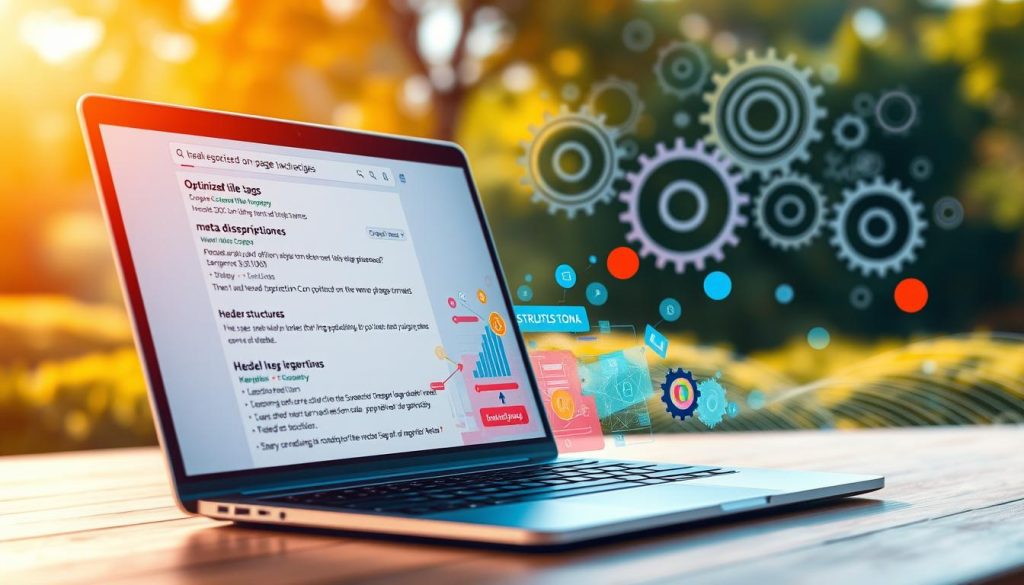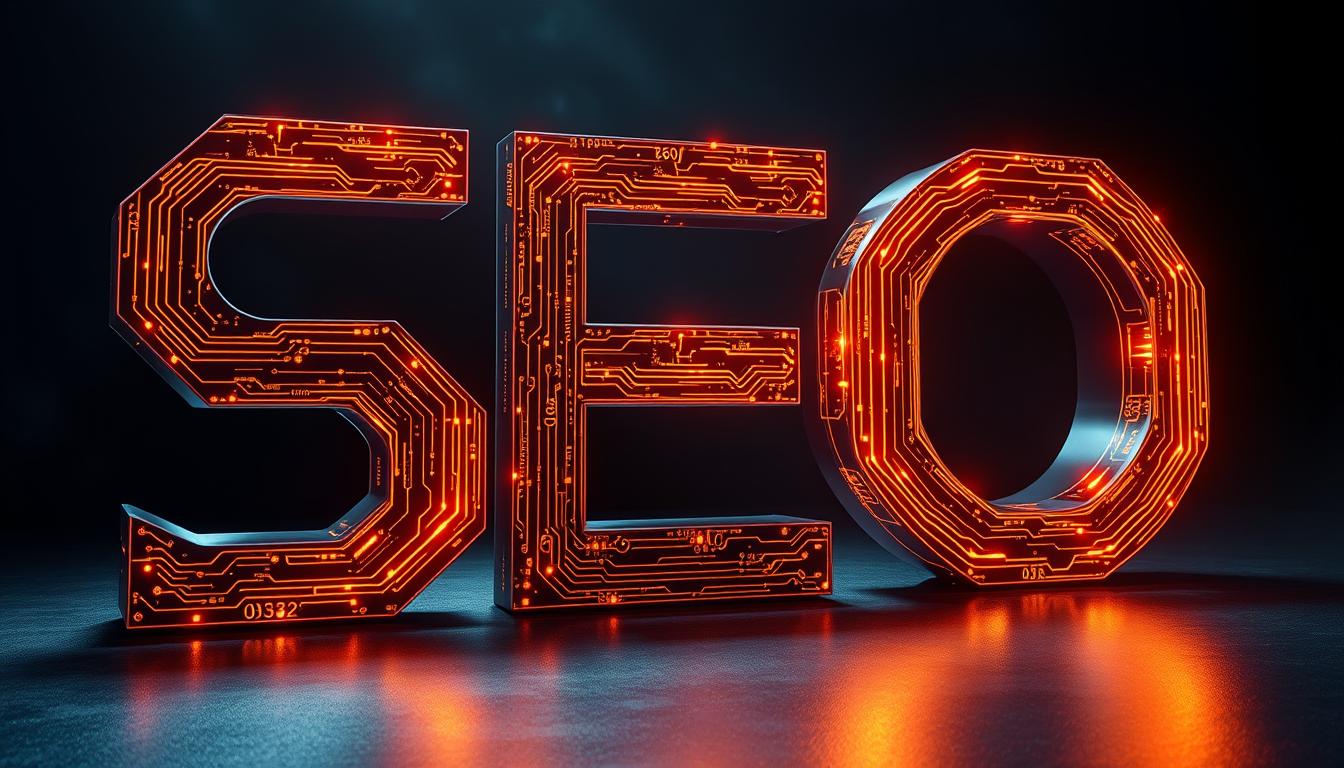Did you know that over 90% of online experiences begin with a search engine? This staggering statistic highlights the importance of search engine optimization (SEO) in today’s digital landscape. In a world where online presence is crucial, SEO plays a vital role in ensuring your website or content is visible to your target audience.
As we dive into the ultimate guide to SEO, you’ll discover the strategies and techniques necessary to improve your website’s ranking on search engines. From understanding the basics of SEO to advanced techniques like keyword research and link building, this guide is designed to be your comprehensive resource.
Key Takeaways
Table of Contents
- Understand the fundamentals of SEO and its role in digital marketing.
- Learn how to conduct effective keyword research.
- Discover strategies for improving your website’s search engine ranking.
- Explore the importance of link building in SEO.
- Gain insights into measuring and analyzing your SEO efforts.
What Is Search Engine Optimization and Why It Matters
As the internet continues to evolve, the significance of SEO in online marketing strategies has become increasingly apparent. Search Engine Optimization is a crucial element for businesses aiming to establish a strong online presence.
How Search Engines Rank Websites
Search engines use complex algorithms to rank websites, considering factors such as content quality, user experience, and SEO strategies. Understanding these factors is key to improving a website’s visibility.
The Business Impact of SEO
SEO services can significantly impact a business by increasing its online visibility, driving more traffic to the website, and potentially leading to higher conversion rates.
Organic vs. Paid Search Results
It’s essential to differentiate between organic and paid search results. Organic results are ranked based on relevance and SEO strategies, while paid results are advertisements. A well-implemented SEO strategy can reduce the need for paid advertising by improving a website’s organic ranking.
Developing an Effective SEO Strategy
Crafting a successful SEO strategy requires a multi-faceted approach that includes setting clear goals, auditing your website, analyzing competitors, and creating a timeline for implementation. This comprehensive strategy is essential for improving your website’s visibility in organic search results.
Setting Measurable SEO Goals
To start, it’s crucial to set measurable SEO goals that align with your business objectives. This could include increasing website traffic, improving search engine rankings, or boosting conversions. By setting specific targets, you can better evaluate the success of your SEO efforts.
Performing a Comprehensive Website Audit
A thorough website audit is vital to identify areas that need improvement. This involves assessing your site’s structure, content, and technical SEO elements to ensure they are optimized for search engines.
Analyzing Competitor SEO Tactics
Understanding your competitors’ SEO strategies can provide valuable insights. Analyze their strengths and weaknesses to identify opportunities for your own SEO efforts.
Creating an SEO Implementation Timeline
Finally, develop a timeline for implementing your SEO strategy. This ensures that your efforts are executed in a structured and timely manner, helping you achieve your SEO goals more effectively.
Mastering Keyword Research
Keyword research stands at the forefront of SEO, guiding your content creation efforts. It’s a critical process that helps you understand what your target audience is searching for online.
Identifying Your Target Keywords
To start, you need to identify the keywords that are most relevant to your business or content. This involves brainstorming a list of terms that your audience might use when searching for information related to your niche.
Understanding User Search Intent
Understanding the intent behind a user’s search query is crucial. Are they looking to buy something, or are they seeking information? Aligning your content with user intent can significantly improve your website ranking.
Utilizing Keyword Research Tools
Several tools can aid in your keyword research.
- Google Keyword Planner is a popular choice for finding keywords and predicting their performance.
- SEMrush and Ahrefs offer comprehensive analyses, including competitor keyword strategies and content gap analysis.
Google Keyword Planner
Google Keyword Planner is a free tool that helps you find keywords and get an idea of their search volume.
SEMrush and Ahrefs
SEMrush and Ahrefs are paid tools that provide detailed insights into keyword performance and competitor analysis.
Implementing Long-tail Keywords for Better Results
Long-tail keywords are more specific phrases that have lower search volumes but are also less competitive. Implementing these can lead to better targeting and higher conversion rates. For example, instead of targeting “shoes,” you might target “women’s size 8 running shoes.”
By mastering keyword research, you can create a robust SEO strategy that drives your content towards higher search engine rankings.
On-Page Search Engine Optimization Techniques
Optimizing your website’s on-page elements is key to achieving higher search engine rankings. On-page SEO involves modifying your website’s content and structure to make it more search engine-friendly, thereby improving your site’s visibility and ranking.
Crafting Optimized Title Tags and Meta Descriptions
Title tags and meta descriptions are crucial elements in on-page SEO. Title tags should be concise, descriptive, and include the primary keyword, while meta descriptions should provide a compelling summary of the page content, enticing users to click through.
- Keep title tags under 60 characters to avoid truncation in search results.
- Ensure meta descriptions are between 150-160 characters for optimal display.
Structuring SEO-Friendly URLs
SEO-friendly URLs are clean, descriptive, and include target keywords. They should be structured to be easily understood by both users and search engines.
For example, a URL like https://example.com/seo-tips is more SEO-friendly than https://example.com/page1.
Optimizing Header Tags Hierarchy
Header tags (H1, H2, H3, etc.) help structure your content and highlight important keywords. Proper use of header tags can improve readability and SEO.
“Header tags are not just about SEO; they improve the overall user experience by making content more scannable.”
Enhancing Image SEO with Alt Text
Using descriptive alt text for images helps search engines understand the content of the images. This can improve your site’s visibility in image search results.

Building Strategic Internal Links
Internal linking helps search engines understand your site’s structure and content hierarchy. It also aids in distributing link equity throughout your site.
- Link to relevant and related content.
- Use descriptive anchor text for internal links.
Improving Page Load Speed
Page load speed is a critical factor in both user experience and SEO. Faster loading pages can lead to higher engagement and better search engine rankings.
Some ways to improve page load speed include optimizing images, leveraging browser caching, and minimizing HTTP requests.
Content Optimization for Higher Rankings
Effective content optimization is the key to securing a top spot in search engine results. By focusing on creating high-quality, relevant content, you can significantly improve your website’s visibility and ranking.
Creating Valuable, Relevant Content
The foundation of content optimization is creating content that is valuable and relevant to your audience. This involves understanding your target audience’s needs and preferences. High-quality content is engaging, informative, and provides solutions to the audience’s queries.
- Conduct thorough research on the topic.
- Identify and address the audience’s pain points.
- Use a conversational tone to engage readers.
Structuring Content for Readability and SEO
Structuring your content is crucial for both readability and SEO. Use header tags (H1, H2, H3) to organize your content and make it easier to read. Clear structure also helps search engines understand the context and relevance of your content.
- Use header tags to create a hierarchical structure.
- Break content into short paragraphs.
- Utilize bullet points and numbered lists.
Incorporating Keywords Naturally
Incorporating keywords naturally into your content is essential for SEO. Avoid keyword stuffing by using keywords contextually and sparingly. The focus should be on creating content that flows naturally and is easy to read.
Optimizing for Featured Snippets
Optimizing for featured snippets can significantly boost your visibility in search results. To achieve this, focus on providing direct, concise answers to common questions related to your content.
Maintaining Content Freshness
Maintaining content freshness is vital for keeping your audience engaged and for SEO purposes. Regularly update your content to reflect the latest information and trends in your niche. This not only improves user experience but also signals to search engines that your content is relevant and up-to-date.
By implementing these content optimization strategies, you can enhance your website’s search engine ranking and provide a better experience for your users.
Off-Page SEO and Link Building Strategies
While on-page SEO is vital, off-page SEO strategies are equally important for achieving higher search engine rankings. Off-page SEO involves actions taken outside of your website to improve its position in search engine results pages (SERPs).
Acquiring Quality Backlinks
One of the most critical off-page SEO factors is acquiring high-quality backlinks from authoritative sites. This can be achieved through creating valuable content that others want to link to.
Leveraging Social Media Signals
Social media presence can indirectly influence your SEO by driving traffic to your site and increasing your content’s visibility, potentially leading to more backlinks.

Implementing Guest Blogging Tactics
Guest blogging on reputable sites is an effective way to build backlinks and establish your brand as an authority in your niche.
| Strategy | Benefits | Actions |
|---|---|---|
| Guest Blogging | Builds backlinks, establishes authority | Research sites, pitch content, write guest posts |
| Social Media Engagement | Increases visibility, drives traffic | Create engaging content, interact with followers |
| Local SEO Optimization | Improves local search visibility | Claim Google My Business, optimize local listings |
Optimizing for Local SEO
For businesses serving specific geographic areas, optimizing for local SEO is crucial. This includes claiming your Google My Business listing and ensuring consistency across local directories.
Managing Online Reviews and Reputation
Online reviews significantly impact your local SEO and overall reputation. Encourage satisfied customers to leave positive reviews and address any negative feedback promptly.
By implementing these off-page SEO and link building strategies, you can enhance your website’s authority, improve your search engine rankings, and drive more traffic to your site.
Conclusion
By implementing the strategies outlined in this guide, businesses can significantly improve their online visibility and drive more organic traffic to their website. A well-planned SEO approach helps websites rank higher in google search results, making it more likely for users to click on them.
As a result, businesses can increase their online presence, reach their target audience more effectively, and ultimately drive more conversions. By focusing on creating high-quality content and optimizing their website for search engines, businesses can reap the benefits of a successful SEO campaign and stay ahead of the competition in the ever-evolving digital landscape.
FAQ
What is the primary goal of search engine optimization?
The primary goal of search engine optimization is to increase the quality and quantity of website traffic by ranking higher in search engines for specific keywords or phrases, thereby improving online visibility and driving organic traffic.
How do search engines rank websites?
Search engines rank websites based on various factors, including keyword usage, content quality, user experience, page load speed, mobile responsiveness, and backlinks from authoritative sources, to determine the relevance and credibility of a website.
What is the difference between on-page and off-page SEO?
On-page SEO refers to the optimization techniques applied directly to a website, such as keyword research, title tags, meta descriptions, header tags, and content optimization, whereas off-page SEO involves external factors like backlinks, social media signals, and online reviews that impact a website’s credibility and ranking.
How often should I update my website’s content for SEO purposes?
Regularly updating your website’s content is essential for SEO, as it signals to search engines that your site is active and relevant, and can help improve your ranking; the frequency of updates depends on your industry, target audience, and content strategy.
What are long-tail keywords, and how can they benefit my SEO strategy?
Long-tail keywords are more specific phrases with lower search volumes, which can be less competitive and more targeted to your content, products, or services, allowing you to attract more relevant traffic and improve your conversion rates.
Can social media signals impact my website’s SEO?
While social media signals are not a direct ranking factor, they can drive traffic to your website, increase brand awareness, and potentially lead to more backlinks from authoritative sources, which can positively impact your SEO.
How do I measure the success of my SEO efforts?
To measure the success of your SEO efforts, track key performance indicators (KPIs) such as organic traffic, search engine rankings, keyword positions, conversion rates, and revenue generated from organic search, using tools like Google Analytics and SEO software.
What is the role of meta tags in SEO?
Meta tags, including title tags and meta descriptions, provide search engines with information about your webpage’s content, helping them understand its relevance and context, and can influence click-through rates and search engine rankings.


